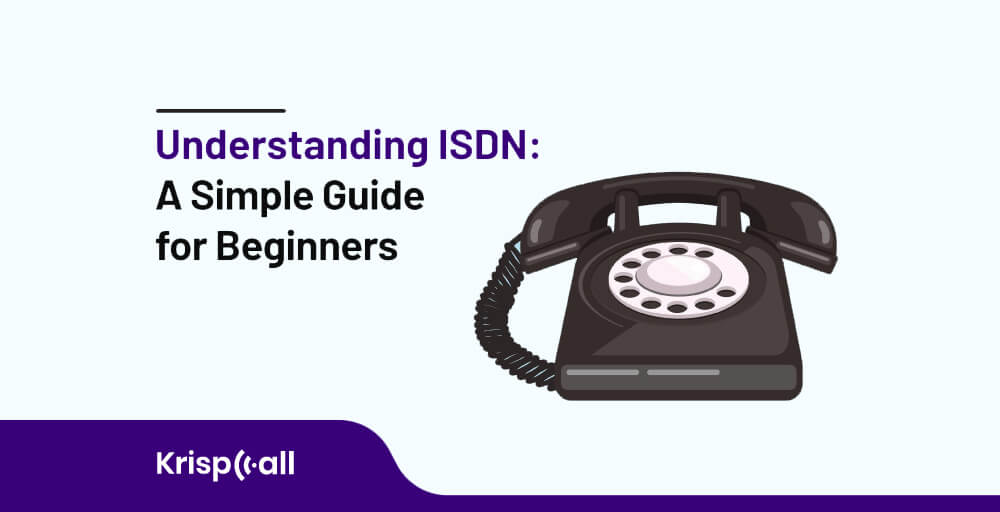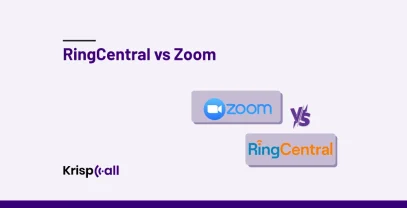Are you new to telecommunications and wondering what ISDN is 🤔?
Don’t worry; we’ve got you covered 🤗.
This blog will demystify ISDN and provide you with a clear understanding of its basics.
🧾 In this guide, you’ll learn about ISDN’s fundamentals, like its origin, applications, and benefits, without being overwhelmed by technical jargon, whether you’re an IT professional or a business owner.
More than this, you will also discover how ISDN can revolutionize your communication infrastructure.
So, let’s get started with the meaning of ISDN.
What is Integrated Service Digital Network (ISDN)?
Integrated Service Digital Network (ISDN) is a telecommunications technology that enables voice, data, and video to be transmitted digitally over copper telephone lines. In comparison to analog systems, it offers faster and more reliable connections between devices.
The ISDN standard was introduced by BT in 1986. With a classic telephone system, it replaced and upgraded old-fashioned landlines with digital lines.
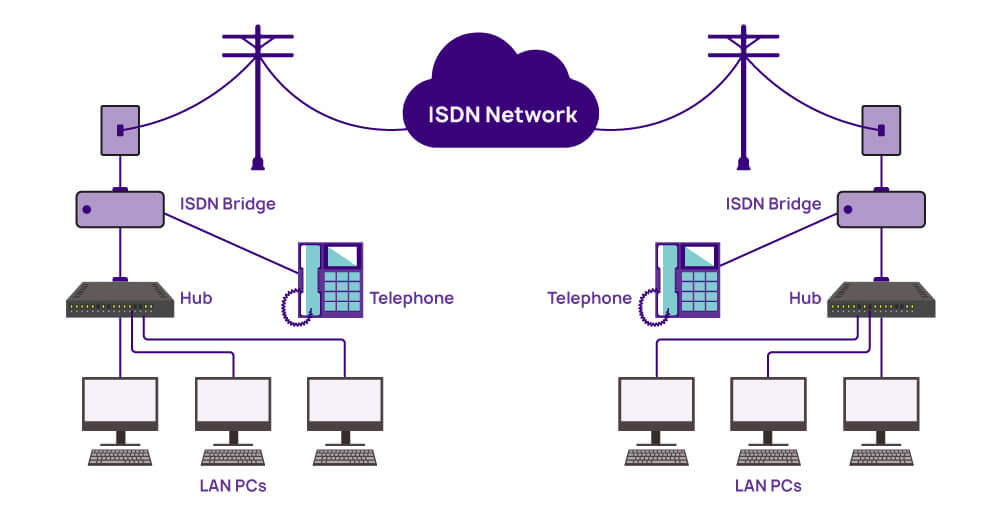
The ISDN transmission line is divided into multiple channels, which makes it possible to make voice calls, conduct video conferences, and transfer high-speed data. Originally, it provided more efficient and versatile communications, but it has largely been replaced by broadband internet technologies such as DSL and fiber optics.
What are the Advantages of ISDN?
ISDN is still used by people in areas without broadband internet. Most of the ISDN internet access services are being phased out. The ISDN service has been improved many times.
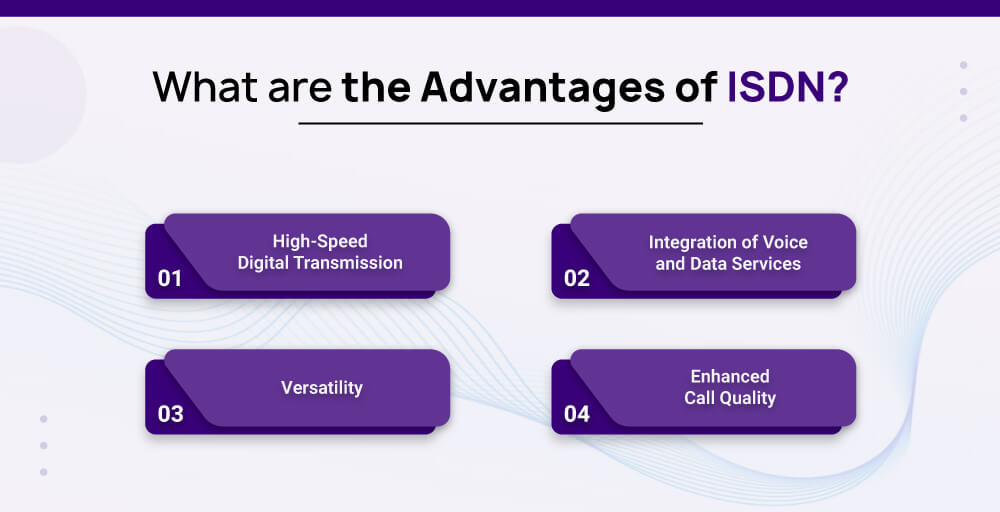
Fiber optic cable was used to transmit data over broadband ISDN, also known as B-ISDN. ISDN BRI also improved voice services.
There are several notable benefits of ISDN, making it such a useful communication technology. You can benefit in several ways by following these steps.
1. High-Speed Digital Transmission
High-speed digital transmission is useful for video conferencing, large file uploads and downloads, and real-time streaming. In PRI configurations, ISDN supports multiple B-channels, which enhances productivity and communication quality for organizations requiring substantial bandwidth.
2. Integration of Voice and Data Services
The efficiency of ISDN has driven its adoption in a variety of sectors, from corporations to hospitals, educational institutions, and government agencies. ISDN services enhance communication capabilities and support a variety of applications.
3. Versatility
Voice calls, video conferencing, faxing, and high-speed internet are all supported by ISDN. Both residential and business applications are suitable for it.
4. Enhanced Call Quality
Compared to analog systems, ISDN provides superior call quality. Communication is clear and crisp thanks to its digital signal.
What are the Types of ISDN?
ISDN channels and configurations come in several types. They are:
1. Narrowband ISDN
Narrowband Integrated Services Digital Network is known as N-ISDN. Data is transmitted over a small spectrum of frequencies using this kind of communication. The goal is to digitize analog speech data. A 64 Kbps circuit switch is used. The narrowband ISDN is used to transmit voice data, which requires a narrower bandwidth.
2. Basic Rate Interface (BRI)
Basic Rate Interface or Basic Rate Access is the ISDN BRI Connection. BRI offers two 64 Kbps bearer or data channels and one 128 Kbps delta or control lane. It’s an average. Many smaller businesses, individuals, and local groups use ISDN BRI connections, limiting coverage.
3. Primary Rate Interface (PRI)
Primary Rate Interface or Primary Rate Access, sometimes called PRI, is used by businesses and offices. There are 23 bearer or data channels and one delta or control lane with 64 Kbps speed and 1.544 Mbps capacity in the US, Canada, and Japan with T-carrier or T1.
PRI configurations in the EU, Australia, and just a few Asian nations use an E-carrier consisting of 30 bearer channels, two delta channels at 64 Kbps, and around 2.048 Mbps bandwidth.
4. Broadband ISDN
B-ISDN stands for Broadband Integrated Services Digital Network. CCITT defines it as “qualifying services or systems requiring transmission paths that can sustain rates above primary.”
Broadband ISDN transmits at rates between 2 Mbps and 1 Gbps and is connected to ATM or Asynchronous Transfer Mode. ISDN typically uses fiber optic cables. Broadband communications are those that exceed 1.544 Mbps. Data is constantly flowing from a centralized location to an infinite number of authorized receivers. The user can access this information flow but cannot control it.
5. B-channel ISDN
SDN operations may also be classified based on the channel that is being used. In the Integrated Services Digital Network (ISDN), the B-channel (Bearer Channel) transmits audio and data. Speech, data, and other low-data-rate communications require this channel. Residential users can enjoy speeds of approximately 64 Kbps.
6. D-channel ISDN
D channel refers to the ISDN channel that transmits control and signaling information. Basic rate interfaces have 16 Kbps, but main rate interfaces have 64 Kbps. D channel technical capabilities include details on the terminal hardware initiating and receiving calls. A terminal must be capable of handling specialized services and features, including the appropriate signaling protocol.
7. H-channel ISDN
H channels consist of bearer B channels bonded together in Principal Rate Access (PRA) or primary rate interface (PRI) frames to accommodate applications with bandwidth requirements greater than 64 Kbps. Throughout the ISDN network, the channels remain bonded across receivers and transmitters.
How does ISDN work?
ISDN converts analog voice and data into digital signals, making communication more reliable and faster. As a result, the digital lines are divided into two categories: B channels and D channels.
For simultaneous voice and data transmission, a Basic Rate Interface (BRI) setup provides 64 Kbps bandwidth per B channel. Due to the time-multiplexing, a large amount of information can be transmitted simultaneously over the channels.
On the other hand, the D channel is responsible for ISDN connection setup, teardown, and control.
The digital nature of ISDN makes this process possible, with several advantages, including improved call quality and the ability to send multiple types of information at once. However, newer broadband technologies are more relevant for most modern communication needs than ISDN.
The following network devices and components are essential to ISDN’s operation:
- TE1: TE1 terminals are ISDN terminals with particular features. It includes digital telephone equipment, such as fax machines and data terminals. All of these devices provide ISDN S-bus interfaces.
- TE2: The Terminal Adapter connects the non-ISDN terminal equipment variant (TE2). There are both analog and 3270 terminal fax phones in the unit.
- TA: It’s a terminal adapter device that serves as an intermediate between ISDN-capable devices and non-ISDN devices. It converts these devices’ non-ISDN interfaces to ISDN interfaces.
There are two types of ISDN terminal adapters: standalone devices and circuit boards included in Terminal Equipment Category 2. There are many types of terminal adapters, including EIA/TIA-232-C, V.24, etc.
- NT1: This is the first variant of network termination. It terminates the line at the customer’s location. Additionally, they can provide line monitoring, power supply, error reports, and accurate timing.
- NT2: NT2 stands for Network termination variant 2. Data is swapped, multichanneled, compressed, and disseminated for and on behalf of the customer. Type 2 Network termination examples include a local area network (LAN) server or a Private Branch Exchange (PBX).
What to set up an ISDN Connection?
ISDN connections are set up by plugging in the telephone company line and connecting a serial port. Setting up ISDN involves the following steps:

Step 1: Programming the modem and loading the modem driver disk
Step 2: Locating the right phone numbers using the modem
Step 3: Choosing the right connection speed for each line
Step 4: Call your ISP (Internet Service Provider). ISPs should provide you with this number.
Step 5: If necessary, enable BONDING (the ability to dial two phone numbers simultaneously so your modem can access higher speeds) on your modem.
What are the different ISDN channels?
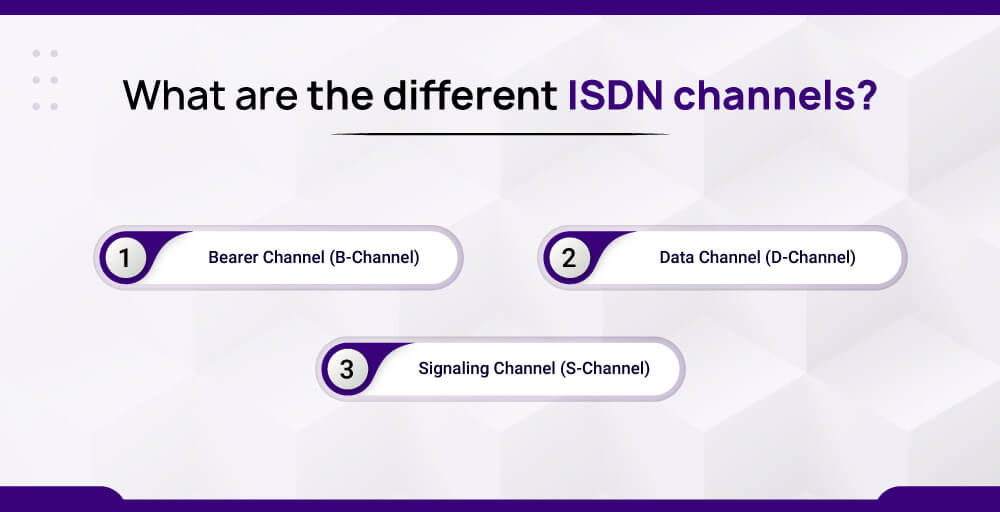
1. Bearer Channel (B-Channel)
Bearer Channels carry voice, data, and video traffic between connected parties. With a bandwidth of 64 Kbps (kilobits per second), it can transmit a variety of information.
ISDN’s B-Channels facilitate simultaneous communication between users. Its versatility makes it suitable for phone calls, video conferencing, and digital data transmission.
2. Data Channel (D-Channel)
ISDN connections are set up, taken down, and managed by Data Channels. D-Channel bandwidth is typically 16 Kbps, which is lower than B-Channel bandwidth.
The D-Channel can be used to coordinate actions such as initiating calls, negotiating features, and managing call status between devices. Signaling protocols used include LAPD (Link Access Procedure for D Channel) and Q.931.
3. Signaling Channel (S-Channel)
Signaling channels are specialized communication channels that exchange control and management information within telecommunications networks. A separate channel is used for transmitting user data, such as voice, video, and digital content.
A signaling channel initiates and terminates calls, manages call features such as forwarding and call waiting, and negotiates capabilities and components. They ensure communication sessions are established, controlled, and maintained efficiently and securely.
ISDN and DSL: What are the Differences?
The key differences are few when it comes to ISDN and DSL. Compared to ISDN, DSL transmits data much faster. Due to ISDN’s dial-up nature, users can only access one line at a time. There is no need to dial for DSL connections. Often, they are referred to as “always-on connections.”
DSL can send packets at speeds of up to 100 Mbps, while ISDN can only deliver packets at speeds of around 128 kbps.
Despite providing the same service, these two function in completely different ways.
| Aspect | ISDN | DSL |
| Speed | 64 Kbps and 128 Kbps. | 128 Kbps to over 100 Mbps (latest standards) |
| Price | More expensive due to installation costs. | Generally, it is less expensive due to existing line utilization. |
| Connection Type | Dial-up | Always-on |
| Technology | Analog service using 2 pairs of POTs wires. | Digital circuit using higher-frequency bands on copper lines. |
What is the Alternative Method to ISDN?
The best alternative method to ISDN is VoIP and SIP. A SIP trunk provides similar functionality as a cloud phone service (VoIP), but lacks advanced phone features.
Voice over Internet Protocol (VoIP) converts audio signals into digital transmission data. Data can be sent from point to point over the internet. VoIP is replacing traditional telephone lines. It allows users to place phone calls over the Internet without having a physical phone line.
VoIP can be accessed in several ways. There are a variety of ways to connect computers, including ATAs (analog telephone terminal adapters), computers, and IP phones.
Shifting from ISDN to VoIP is a simple process. Your first step should be determining your business needs/wants and how many extensions you need. After that, select the best VoIP provider, like KrispCall. The providers will handle all the setup processes for you. Likewise, your business will not face significant impacts due to the seamless transition from ISDN to IP technology.
Comparison Between ISDN & VoIP
| Factors | ISDN | VoIP |
| Form | Installation of an external physical circuit is required. | Connect to existing internet connection without requiring external sources. |
| Reliability | The system is difficult to set up and is prone to failure. | Easy to set up, has low failure rates, and is suitable for primary or secondary use |
| Flexibility | Requires a contract/geographic area code, so it may take several weeks to change. | Adapts to changes instantly and is not limited by geography. |
| Cost | Bearer channels are expensive to implement and use. | Calls are 40-90% cheaper with low install costs. |
| Futureproofing | The product has expired with a confirmed end-of-life date. | Cost-effective, customizable, and scalable. |
Upgrade Limited Analog Lines (ISDN) to KrispCall Modern Cloud Phone Today
It’s no wonder that VoIP is more advanced and outranks ISDN in every aspect. Its flexibility and cost-effectiveness make it worth considering. The differences between the two can be seen from the table above.
ISDN is an older system with weaknesses. On the other hand, VoIP offers so much more than just lower costs and flexibility. Hence, upgrade your analog lines (ISDN) to KrispCall, a Modern Cloud Phone today, and enjoy the benefits of VoIP.
Here’s why you should make the switch:
- Cost: VoIP phones offer calls at lower rates and do not require additional hardware to make communications. You can also make international calls without roaming charges, which helps to save you a fortune in business communications.
- Accessibility: VoIP can be used anywhere with an internet connection. It is similar to your email account in that you use it as your telephone line and sign in using your ID. You’ll just need a device and an internet connection.
- Scalability: If you need to add an extra line, VoIP is the easiest method. You don’t need a physical line, and you can scale your members (add or remove members) with a single click of a button.
- Voice Quality: With a stable internet connection, users will experience sound quality that is comparable to traditional landlines. Internet connection issues are the only issues that arise with VoIP call quality.
- More Features: With VoIP, you will get to experience several features like,
- Unified Callbox
- Call waiting
- Call Forwarding
- Voicemail
- Automatica call distribution
- Caller ID
Final Words
The market for ISDN has declined steadily as newer technologies, such as fiber optics and high-speed broadband, have dominated. VoIP has risen as its best alternative. Voice over IP is clearly changing people’s experiences while conducting business communications. More importantly, it gives businesses more flexibility than ever before.
VoIP allows seamless team collaboration via an online portal, connecting mobile phones to business lines and connecting cell phones to business lines. Moreover, it helps businesses reduce upfront and monthly costs associated with traditional phone service. Hence, if you are considering shifting from ISDN to VOIP, consider trusting KrispCall. KrispCall provides VoIP services at a lower cost without compromising on quality.
FAQs
How much does it cost to set up using ISDN?
Setting up ISDN costs $140, and usage charges range from $29 to $250 per month.
What are the different alternatives to ISDN?
The different alternatives to ISDN are VoIP, SIP, Hybrid Phone Systems, Hosted Phone Systems, and IP Phone Systems.
What is the function of an ISDN modem?
The function of the ISDN modem is to provide standards for simultaneous digital transmission of voice, video, data, and other network services over digitalized telephone circuits.
What are the devices used in ISDN?
The devices used in ISDN are:
- Terminals,
- Terminal adapters (TAs),
- Network-termination devices,
- Line-termination equipment,
- Exchange-termination equipment.
Does ISDN use the Internet?
An ISDN network (Integrated Services Digital Network) does not use the internet in the traditional sense. Instead, it uses conventional phone lines or T1 connections to transmit both data and voice over digital channels.
However, ISDN can be used in conjunction with the internet for certain services, such as broadband ISDN (B-ISDN), which transmits data over fiber optic cable.
What do you mean by ISDN Switchoff?
The ISDN switch-off is a new plan that BT announced back in 2015 in which the country will switch from copper to fiber in 2025, converting the old copper network to digital. As per the plan, businesses will have to implement an alternative to ISDN lines (and any hardware that relies on them).

